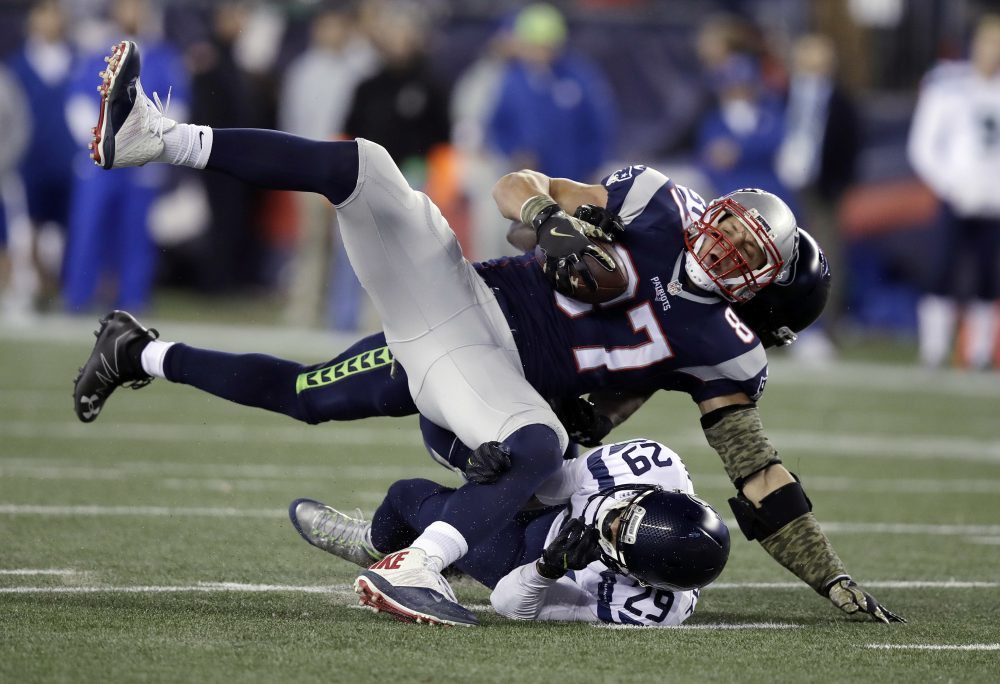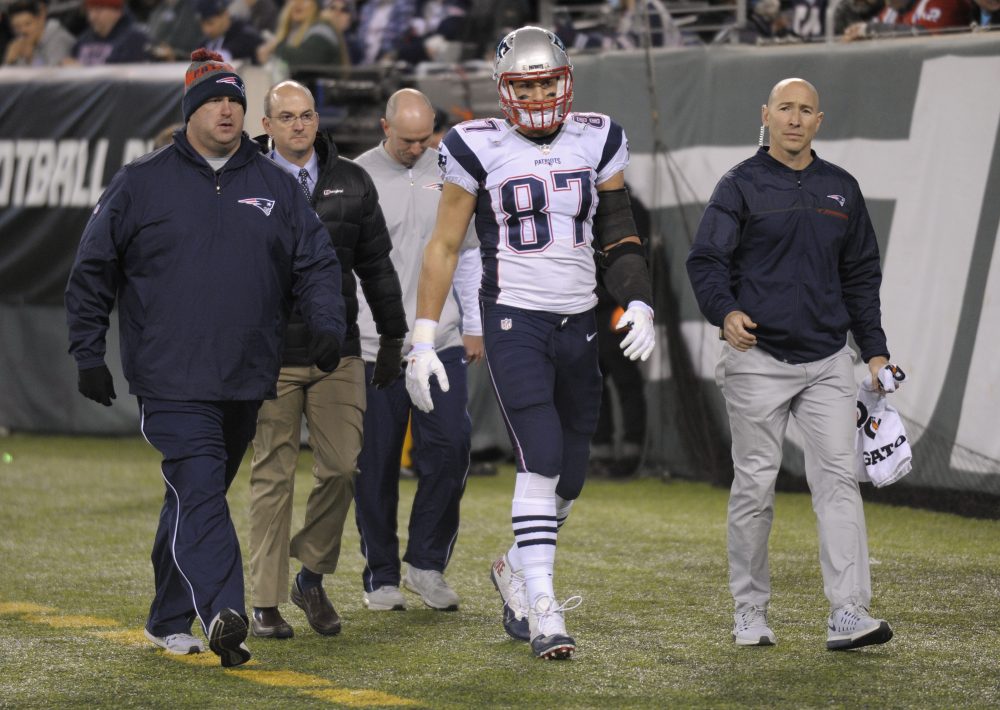Advertisement
Bad Luck And Body Type: As Pats Lose Gronk, Weighing Whether Some Athletes Are Injury-Prone
Resume
Not again. That's how New England Patriots fans reacted when tight end Rob Gronkowski recently injured his back. After he underwent season-ending back surgery, the worst fears of his teammates and fans were confirmed.
Throughout his Patriots career, Gronkowski has struggled to stay healthy for an entire season. Looking at his lengthy list of injuries, it’s easy to wonder whether some NFL players are more susceptible to injury than others. And what that might mean for the rest of Gronkowski's career.
Gronkowski’s injuries include a broken left forearm, torn right ACL and MCL, sprained ankle, tweaked hamstring, concussion and severely bruised chest. Now, he’s out with a surgically repaired back. Again. It’s the third back surgery of his playing career, including one dating back to his days at the University of Arizona.
Gronk has undergone eight total surgeries as an NFL player.
But the big tight end is not alone in the NFL when it comes to long lists of injuries. Some players are sidelined as frequently as Gronkowski or more.

Is it fair to call such dinged-up players injury-prone? Herm Edwards, a former NFL player and coach, says some athletes can’t avoid that label — and the consequences it has for their careers.
“After a while, a pattern starts, some players seem to always be available and some players are not,” says Edwards. “You've seen great players that have had short careers due to the fact that they've been injured a lot. When you're an athlete, the one thing you're concerned about is injury, because that's the No. 1 thing that can take you out. It's not so much your ability, but you're inability to be available.”
Now an NFL analyst with ESPN, Edwards wishes he knew why some players get hurt far more often than others. As a player, he managed to stay remarkably injury-free. In his first nine NFL seasons, he never missed a game with the Philadelphia Eagles.
“I didn't do anything different,” says Edwards. “Was I hurt sometimes? Yeah. But not to the point where I couldn't play. I think we all go through it. Some guys escape it. Some guys don't. There's no secret formula. I worked out like everybody else. I didn't do anything different than anybody else did. I was just very fortunate.”
... The one thing [athletes are] concerned about is injury, because that's the No. 1 thing that can take you out. It's not so much your ability, but you're inability to be available.
Herm Edwards
From a medical standpoint, Dr. Tarek Souryal doesn’t view frequently sidelined athletes as injury-prone. His perspective comes from his experience as a Dallas-based orthopedic surgeon who’s treated more than 300 NFL players.
"I have seen many players get injured over and over again,” says Souryal. “But it's no fault of their own. I don't think that injury-prone exists. I think this is just unlucky and more likely a reflection of the sport rather than the person."
That’s because NFL players are bigger and faster than they used to be. Also, different playing styles can put some athletes at greater risk.
Case in point: the 6-foot-6, 265-pound Gronkowski.
Edwards sees it every time the Patriots player takes the field.
“He takes a lot of hits, because of the way he runs with the ball,” says Edwards. “I've always said he's an athlete that's a clumsy athlete. He doesn't fall soft ... It's not his fault. It's just his body type.”
Mike Boyle, a Woburn-based strength and conditioning coach who’s worked with hundreds of NFL clients, adds: “[Gronkowski is] one of those guys who's not a ducker or a slider or a guy who's trying not to get hit. He probably is a guy who almost relishes the contact part of it.”
According to Boyle, smarter, more functional training is one way athletes can reduce their injury risk, especially as they age. But there are no guarantees, especially with violent collisions such a big part of football.
I don't think that injury-prone exists. I think this is just unlucky and more likely a reflection of the sport rather than the person.
Dr. Tarek Souryal
Gronkowski’s latest back surgery ended his season -- the third time that’s happened in his seven-year career. As the 27-year-old gets older, the cumulative effect of all the injuries and surgeries will take a greater and greater toll on his body.
So, while Dr. Souryal is impressed with Gronkowski’s resiliency, the orthopedic surgeon wonders how many more times Gronk can come back from a significant injury and still be the best at his position.
“After his forearm fracture, you kind of wondered, he just had three surgeries, is he going to be able to catch a ball?” says Souryal. “Well, we don't even talk about that anymore. After his ACL, you wonder, hey is he going to be able to cut? And he did it. I'm sure the same question is being asked about his third spine surgery. But if you take his personality out of the equation and you're just looking at a player who's 27 who's had multiple surgeries, you wouldn't think that he's got much left in the tank.”
Given his history, it’s almost certain this won’t be Gronkowski’s last significant injury.
That’s always part of the NFL equation.
“Some guys just get hurt,” says Edwards. “Sorry to say. It's part of the deal."
This segment aired on December 7, 2016.
